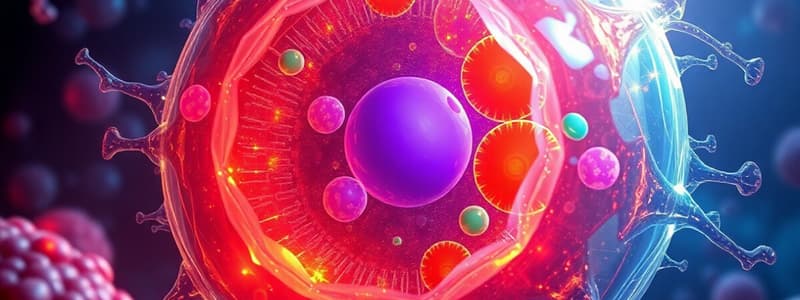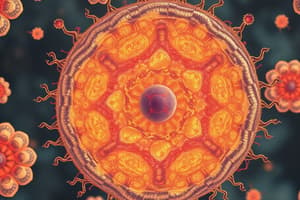Podcast
Questions and Answers
A researcher is studying a new drug that inhibits a specific motor protein. If cells treated with this drug exhibit a significant reduction in the transport of vesicles towards the cell periphery, which motor protein is most likely affected?
A researcher is studying a new drug that inhibits a specific motor protein. If cells treated with this drug exhibit a significant reduction in the transport of vesicles towards the cell periphery, which motor protein is most likely affected?
- Integrin
- Kinesin (correct)
- Myosin
- Dynein
A patient presents with a genetic disorder affecting the structure of collagen. Which component of the extracellular matrix is primarily affected, leading to a compromised ability to withstand tensile forces?
A patient presents with a genetic disorder affecting the structure of collagen. Which component of the extracellular matrix is primarily affected, leading to a compromised ability to withstand tensile forces?
- Proteoglycans
- Elastin
- Collagen (correct)
- Integrins
A toxin disrupts the function of the smooth endoplasmic reticulum in liver cells. Which cellular process would be most directly impaired?
A toxin disrupts the function of the smooth endoplasmic reticulum in liver cells. Which cellular process would be most directly impaired?
- Lipid Synthesis and Detoxification (correct)
- ATP Synthesis
- Post-Translational Protein Modification
- Protein Synthesis
A researcher is investigating a signaling pathway activated by a receptor tyrosine kinase (RTK). Activation of which downstream pathway would lead to increased cell growth and proliferation?
A researcher is investigating a signaling pathway activated by a receptor tyrosine kinase (RTK). Activation of which downstream pathway would lead to increased cell growth and proliferation?
A new drug is developed to target cancer cells by disrupting a key step in glycolysis. Which enzyme, when inhibited, would most effectively reduce the ATP production in these cells?
A new drug is developed to target cancer cells by disrupting a key step in glycolysis. Which enzyme, when inhibited, would most effectively reduce the ATP production in these cells?
A patient with a mitochondrial disorder exhibits decreased ATP production. Which process within the mitochondria is most likely impaired?
A patient with a mitochondrial disorder exhibits decreased ATP production. Which process within the mitochondria is most likely impaired?
A researcher is studying familial hypercholesterolemia. Which of the following is a key characteristic of this condition that increases the risk of atherosclerosis?
A researcher is studying familial hypercholesterolemia. Which of the following is a key characteristic of this condition that increases the risk of atherosclerosis?
A patient presents with a urea cycle disorder due to a deficiency in ornithine transcarbamylase. Which laboratory finding would be most indicative of this condition?
A patient presents with a urea cycle disorder due to a deficiency in ornithine transcarbamylase. Which laboratory finding would be most indicative of this condition?
During DNA replication, which enzyme is responsible for relieving the torsional stress caused by the unwinding of the DNA strands?
During DNA replication, which enzyme is responsible for relieving the torsional stress caused by the unwinding of the DNA strands?
A cancer cell has developed a mutation that allows it to evade apoptosis. Which protein is most likely affected by this mutation?
A cancer cell has developed a mutation that allows it to evade apoptosis. Which protein is most likely affected by this mutation?
Which of the following immune cells is primarily responsible for directly killing virus-infected cells?
Which of the following immune cells is primarily responsible for directly killing virus-infected cells?
During T cell activation, what is the primary role of antigen-presenting cells (APCs)?
During T cell activation, what is the primary role of antigen-presenting cells (APCs)?
A bacterium uses adhesins to colonize the respiratory tract. What is the primary function of adhesins in bacterial pathogenesis?
A bacterium uses adhesins to colonize the respiratory tract. What is the primary function of adhesins in bacterial pathogenesis?
A patient develops tissue damage due to ischemia followed by reperfusion. Which mechanism contributes most significantly to the cell injury observed in ischemia-reperfusion injury?
A patient develops tissue damage due to ischemia followed by reperfusion. Which mechanism contributes most significantly to the cell injury observed in ischemia-reperfusion injury?
In a Type I hypersensitivity reaction, such as an allergy, which antibody isotype is primarily involved in sensitizing mast cells?
In a Type I hypersensitivity reaction, such as an allergy, which antibody isotype is primarily involved in sensitizing mast cells?
Flashcards
Prokaryotic Cells
Prokaryotic Cells
Cells lacking a nucleus or membrane-bound organelles; characterized by circular DNA and 70S ribosomes.
Eukaryotic Cells
Eukaryotic Cells
Cells containing a true nucleus and membrane-bound organelles, facilitating complex functions.
Phospholipid Bilayer
Phospholipid Bilayer
The basic structural unit of the cell membrane, composed of hydrophilic heads and hydrophobic tails.
Mitochondria
Mitochondria
Signup and view all the flashcards
Nucleus
Nucleus
Signup and view all the flashcards
Rough ER
Rough ER
Signup and view all the flashcards
Smooth ER
Smooth ER
Signup and view all the flashcards
Golgi Apparatus
Golgi Apparatus
Signup and view all the flashcards
Lysosomes
Lysosomes
Signup and view all the flashcards
Collagen
Collagen
Signup and view all the flashcards
Kinesin
Kinesin
Signup and view all the flashcards
Dynein
Dynein
Signup and view all the flashcards
Hexokinase
Hexokinase
Signup and view all the flashcards
Metastasis
Metastasis
Signup and view all the flashcards
Receptor Tyrosine Kinases (RTKs)
Receptor Tyrosine Kinases (RTKs)
Signup and view all the flashcards
Study Notes
Structure of Cells
- Prokaryotic cells lack a nucleus and membrane-bound organelles. Their DNA is circular, and they have smaller ribosomes (70S).
- Eukaryotic cells possess a true nucleus, membrane-bound organelles, and are typically larger in size compared to prokaryotic cells.
- The cell membrane comprises a phospholipid bilayer with hydrophilic heads and hydrophobic tails, along with integral and peripheral proteins and cholesterol, which contributes to membrane fluidity.
- Mitochondria synthesize ATP through oxidative phosphorylation, regulate apoptosis, have a double membrane, and their DNA is maternally inherited.
- The nucleus stores DNA, regulates transcription, and contains nuclear pores that control the movement of substances in and out.
- The rough ER is involved in protein synthesis for secretion or membrane integration and is characterized by the presence of ribosomes.
- The smooth ER is responsible for lipid synthesis, detoxification processes, and calcium storage.
- The Golgi apparatus modifies proteins post-translationally, sorts them, and facilitates vesicular trafficking.
- Lysosomes contain hydrolytic enzymes and are involved in autophagy and phagocytosis.
- Peroxisomes facilitate fatty acid beta-oxidation and hydrogen peroxide detoxification.
- Microtubules, made of tubulin polymers, form the spindle during mitosis and act as vesicle transport pathways.
- Intermediate filaments provide structural integrity and mechanical support to cells, with keratins being an example.
- Microfilaments, composed of actin, are involved in cell migration and muscle contraction through polymerization and depolymerization.
Matrix, Motors, and Movement
- Collagen provides tensile strength to the extracellular matrix (ECM) due to its triple helix structure.
- Elastin contributes to tissue elasticity within the ECM.
- Proteoglycans in the ECM help retain water and provide cushioning.
- Integrins facilitate cell adhesion and signal transduction within the ECM.
- Kinesin motor proteins transport cargo toward the plus end of microtubules, away from the nucleus.
- Dynein motor proteins are involved in retrograde transport and facilitate ciliary and flagellar beating.
- Myosin motor proteins use ATP to slide actin filaments in muscles, enabling muscle contraction.
Cell Signaling and Movement
- G protein-coupled receptors (GPCRs) activate different pathways, including Gαs/cAMP, Gαq/IP3/DAG/Ca2+, and Gαi inhibitory pathways.
- Receptor tyrosine kinases (RTKs) activate the MAP kinase cascade and PI3K-AKT pathway.
- Steroid hormones bind to intracellular receptors and regulate gene transcription.
- Secondary messengers like cAMP, IP3, DAG, and Ca2+ amplify signaling pathways.
- Cell migration involves chemotaxis and lamellipodia formation, with actin polymerization regulated by Rac, Rho, and CDC42.
Pharmacology: Absorption, Distribution, Metabolism, Excretion (ADME)
- Absorption involves bioavailability and is influenced by first-pass metabolism and the route of administration (oral vs. IV).
- Distribution is affected by lipophilicity, tissue perfusion, plasma protein binding, and the blood-brain barrier.
- Metabolism occurs in two phases: Phase I involving CYP450 oxidation and Phase II involving conjugation, glucuronidation, and acetylation.
- Excretion involves renal clearance mechanisms (glomerular filtration, tubular secretion) and hepatic clearance.
Glucose and Energy Metabolism
- Key enzymes in glycolysis include hexokinase, phosphofructokinase-1, and pyruvate kinase, which are also regulation points.
- Rate-limiting enzymes in the TCA cycle are citrate synthase and α-ketoglutarate dehydrogenase.
- The electron transport chain involves Complexes I-IV, ATP synthase, and oxygen, which acts as the final electron acceptor.
- Insulin and glucagon regulate glycogenesis, glycogenolysis, and gluconeogenesis.
Lipid Metabolism and Dyslipidemias
- Fatty acid metabolism involves detailed beta-oxidation steps and is regulated by insulin and glucagon.
- Cholesterol metabolism includes cholesterol synthesis, with HMG-CoA reductase as a key enzyme, and the functions of LDL and HDL.
- Dyslipidemias include familial hypercholesterolemia and are linked to clinical correlations such as atherosclerosis risk.
Protein Metabolism
- Amino acid catabolism involves transamination, using ALT/AST enzymes, and the urea cycle, where ornithine transcarbamylase deficiency can occur.
- Nitrogen balance has clinical significance in nutritional assessment.
- Metabolic integration considers the fed vs. fasting state, including gluconeogenesis substrates during fasting.
Nucleic Acids
- DNA replication is semi-conservative and involves helicase, primase, and DNA polymerase proofreading.
- Transcription involves promoters, enhancers, transcription factors, and RNA splicing.
- Translation involves codon-anticodon pairing, elongation factors, and ribosome structure.
Carcinogenesis and Cancer Genetics
- Tumor biology includes p53 mutations, oncogenic signaling (RAS/MAPK pathway), apoptosis evasion, and limitless replication potential.
- Metastasis mechanisms involve EMT (epithelial-mesenchymal transition), angiogenesis factors (VEGF), invasion of the basement membrane, and the tumor microenvironment.
Immunology: Innate Immunity
- Macrophages, neutrophils, dendritic cells, and NK cells are key cell types in innate immunity.
- The inflammatory response involves cytokines (IL-1, IL-6, TNFα), the complement system, and pathogen recognition by PRRs (TLRs). It can be acute or chronic, with inflammatory mediators such as histamines, prostaglandins, and leukotrienes.
Adaptive Immunity
- T/B cell activation involves MHC molecules, co-stimulatory signals, cytokine roles, clonal selection, and antigen presentation by APCs.
- Antibody functions include neutralization, opsonization, complement activation, class switching, and affinity maturation.
Infectious Diseases
- Bacterial pathogenesis involves adhesins, toxins (endotoxin/LPS vs. exotoxins), biofilms, and antibiotic resistance mechanisms.
- The viral life cycle includes attachment, entry, replication, and release mechanisms, as well as viral latency and host immune evasion.
- Fungal/parasitic infections have distinct clinical features and are treated with antifungal drugs (azoles, polyenes) and antiparasitic drugs (antimalarials, antihelminthics).
Introduction to Pathology
- Cell injury includes apoptosis (caspase activation) and necrosis patterns (coagulative, liquefactive, caseous, fibrinoid, fat necrosis), as well as ischemia-reperfusion injury.
- Inflammation involves mediators (histamine, cytokines), outcomes (resolution, chronic inflammation, fibrosis), granulomatous inflammation, and hypersensitivity reactions (Type I-IV).
Studying That Suits You
Use AI to generate personalized quizzes and flashcards to suit your learning preferences.




